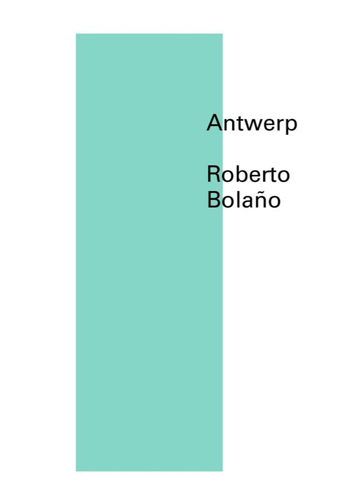
by by Margaret Kolb

Published by New Directions, 2010 | 78 pages
Written in 1980, Antwerp is Bolaño’s first completed novel, one he initially did not intend to publish. Its posthumous translation into English follows upon last year’s great success of 2666. In the introduction he wrote to Antwerp in 2002, Bolaño describes his younger self as a man poised on the brink of changes that will soon reorient his life: teetering between prose and poetry, distrust of the publishing industry and literary ambition, serious dreams of writing and tongue-in-cheek petty crime schemes. The novel’s principal aim seems to be formally to express this state of precariousness, of a barely kept balance. As a result, Antwerp is torn uncertainly between two formal impulses: the epic narrative and the modernist lyric. This double preoccupation is at once Antwerp’s greatest strength and its major drawback.
Made out of fifty-six one- or two-page-long fragments, the novel sketches out a rudimentary murder mystery. Narration rapidly switches focus among a dozen different characters: among others, a young girl raped and murdered; the many mouths that retell her story as it ripples through the neighborhood (but are sometimes mysteriously muted); a policeman collecting clues; a mysterious hunchback loitering in the streets; a young writer, “Roberto Bolaño,” in whose notebook the whole story gradually sediments. This plot unravels disjointedly. At times, Bolaño suggests that it is only the narrator’s dream. At other times, through parenthetical mentions of “the screen” and “applause,” he compares his novel to a movie theater in which random, fragmented images are projected.
Antwerp’s first, more confidently executed tendency is to present itself as a small-scale epic: a tale of communities rather than individuals, of mass movements viewed from a considerable distance. As such a portrait of his place and time, Antwerp inaugurates many themes that will become fixtures of Bolaño’s sweeping style: gang warfare, sexual violence, Spanish and South American urban landscapes. “In Barcelona a South American is dying in a foul-smelling room. Police dragnets. Cops who fuck nameless girls. The English writer talks to the hunchback in the woods.” The multiplicity of these characters—crowdedly populating what are no more than seventy pages of text—makes it seem as if our protagonist were not any single person but a city, a time of day, an atmosphere. Bolaño’s ventures into a murky magical realism and his wry sense of humor add to this sense of epic aerial detachment: “I wish those miserable people in the windows would turn out the lights and go to sleep. Who was the first human being to look out a window? (Applause.)”
At the same time, a second force is continually at work in Antwerp: a force which complements but also obstructs the text’s desire for narrative sweep. Into the novel’s fragmented crime narrative, a voice keeps intruding that tries to piece these fragments together not as a convoluted communal story but as a lyric statement; to center them not around a broader community, but around the vulnerable sensibility of a single observer, the person composing this text.
At times, the ambiguity this second, lyric tendency introduces is enriching. It very productively haunts collections of loose phrases scattered throughout many of Antwerp’s small chapters: “‘We act on instantaneous impulses’… ‘This is the kind of thing that destroys the unconscious, and we’ll be left hanging.’” Antwerp’s prominent epic features tempt one to classify such scraps of language as a communal polyphony. Yet, they also play an introspective, lyric function: displaying, at least as much they do the sounds of a community, the sensibility and emotions of the person selecting and arranging them. Stuck between these two options, we find ourselves pulled more deeply into the fabric of the text; more curious both about the person observing these diverse scenes and in the scenes in and of themselves.
At other times, however, this technique results in awkward anticlimaxes:
A naked boy sitting outside his tent in the woods? The girl stumbled into the bathroom and began to vomit. When you think about it, we’re not allotted much time here on earth to make lives for ourselves: I mean, to scrape something together, get married, wait for death.Reading fragments like this, one finds oneself disengaged rather than attracted. The reader—and, indeed, it seems, the author himself—is unable to decide whether to focus on the eerie vignettes at hand or on the observer from whose perspective we see them; on the children’s strange, inexpressible isolation or on the voice that nevertheless wants to make aphoristic sense of the scene. Unlike in the prior case, here these two alternatives undercut rather than intensify each other. What could have been a moment of emotional poignancy falls flat.
Antwerp’s hesitation between the epic and the lyric raises issues of form and tone Bolaño’s later fiction will be much better equipped to address. In 2666 and in The Savage Detectives, subjective sensibilities are distributed among many characters, each of whom we will learn to trust only partly; our desire for a central lyric consciousness is at once expressed and gently mocked by prolonged pursuits of fictional novelists and poets. Yet, if Antwerp’s hesitations are what occasionally makes the novel jarring, they are also its main source of value. The question Bolaño seems to be asking of himself in this novel: how do you represent radical subjectivity and communal diversity at once, in a society whose structures have become unstable? is still pertinent to today’s fiction. The novel sets a stage for contemplating not only the specific answer Bolaño later gives to this question, but also broader contradictions most current novelists must struggle with.
Marta Figlerowicz is a graduate student in English at the University of California, Berkeley. Her criticism and creative writing have appeared or are forthcoming in, among others, Film Quarterly, New Literary History, The Journal of Modern Literature, Qui Parle, Dix-huitieme siecle, Prooftexts, Romance Sphere, The Harvard Advocate, and The Harvard Book Review.















click to see who
MAKE Magazine Publisher MAKE Literary Productions Managing Editor Chamandeep Bains Assistant Managing Editor and Web Editor Kenneth Guay Fiction Editor Kamilah Foreman Nonfiction Editor Jessica Anne Poetry Editor Joel Craig Intercambio Poetry Editor Daniel Borzutzky Intercambio Prose Editor Brenda Lozano Latin American Art Portfolio Editor Alejandro Almanza Pereda Reviews Editor Mark Molloy Portfolio Art Editor Sarah Kramer Creative Director Joshua Hauth, Hauthwares Webmaster Johnathan Crawford Proofreader/Copy Editor Sarah Kramer Associate Fiction Editors LC Fiore, Jim Kourlas, Kerstin Schaars Contributing Editors Kyle Beachy, Steffi Drewes, Katie Geha, Kathleen Rooney Social Media Coordinator Jennifer De Poorter
MAKE Literary Productions, NFP Co-directors, Sarah Dodson and Joel Craig